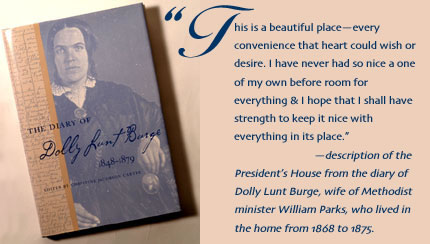|
‘The
Most Precious Memories’
Emory’s
oldest residence, the President’s House in Oxford has housed
Methodist ministers, college presidents, and the Deans of Oxford
College — and their families—for nearly one hundred
and seventy years.
The
President’s House at Oxford College, Emory’s oldest
property, remains a serene, beautiful place, just as it was when
the Reverend William Parks’ wife, Dolly Burge, lived there
in 1868.
And,
for the first time in its history, a woman lives in the house
not because she is the spouse of an Emory president, Methodist
minister, or Oxford dean, but because she is dean.
Dana
Greene ’71G has occupied both the job and the residence
since July 1999. This spring morning, fresh strawberries sit
on the kitchen counter, and camellias have been plucked from
a bush just outside the back door and placed in a vase. Greene’s
first grandchild, three-month-old Sofia, is visiting.
“One
of the great treats of this job is to live in this house,”
she says, looking out onto a generous expanse of lawn from the
kitchen’s bay window.
The
stately yet comfortable house seems to engender strong attachments.
Built
in 1836 for Emory President Ignatius Alphonso Few, first president
of Emory College and a founder of both the college and the town
of Oxford, the residence served as home to leaders of the Methodist
Church, such as Parks, and seven Emory presidents–Few,
Augustus B. Longstreet, George F. Pierce, Atticus Haygood, Warren
A. Candler, Charles E. Dowman, and James E. Dickey.
After
Emory moved to Atlanta, the house became the residence of the
deans of Oxford College, including all of the college’s
living deans–N. Bond Fleming ’33C-’36T, J. William
Moncrief, William H. Murdy, and Greene.
Portraits
of many of the home’s former tenants adorn a downstairs
wall. All are men, with the exception of Dolly Burge, who lived
in the house from 1866 to 1875. “I just wanted to have
a woman up there,” says Greene, who hung the portrait and
also keeps a copy of Burge’s diary at hand, which contains
several entries from her years in Oxford.
While
Burge speaks with much happiness of their first few years in
the home after her marriage to “Uncle Billy” Parks,
a prominent Methodist minister, his health failed rapidly. Upon
Parks’ death in 1873, Burge was allowed to stay in the
home for two years, although their furniture was sold to the
highest bidder on the front lawn immediately after his death.

Burge
wrote of the sale in her diary, which has been published in
book form: “It is enough to lay the loved one in the grave
to come home and hide ones self among the fireside relics and
feel that they are all and almost parts of the lost and then
to have them taken by rough hands from us is almost too much!,”
she wrote, later calling herself “a boarder in my own house.”
The
house was purchased by Atticus Haygood 1859C in 1875, the first
year of his Emory presidency, for three thousand dollars. (“It
is worth at least five thousand,” wrote Burge, “and
now that it is done, I almost wish that I had bought it myself
I so much hate to leave it.”)
In
1889, Young L. G. Harris, a member of Emory College’s Board
of Trustees, bought the house and presented it to Emory.
Originally
built in a “two over two” design, with a dining room
and sitting room downstairs, topped by two upstairs bedrooms,
the house at 1205 Wesley Street is a blend of architectural
styles, from Greek revival to Victorian. It has pine floors,
high ceilings, broad molding, and eight fireplaces, seven of
which still function. Large windows provide plenty of cross-ventilation.
“There
are lots of little nooks and crannies,” says Greene. “It
would be fun to be a kid here.”
In
1841, Longstreet added two freestanding wing rooms, which jut
out from opposite ends of the front porch and have their own
entrances and fireplaces. Greene’s husband, Richard, has
taken over one of the rooms as a study.
Former
Oxford Dean William Murdy, who lived in the home from 1988 to
1999, said he and his wife, Nancy, also enjoyed the wing additions,
using one as a game room where they would shoot pool with visiting
students.
Birds,
and sometimes bats, would roost inside the houses’ many
chimneys, he recalls. Once, while sitting outside in the evening,
he counted thirty-four birds flying into a single chimney. “They
could make quite a racket when they were disturbed,” he
said.
“We
loved the house,” Murdy says. “Our children and grandchildren
lived nearby and loved to come and stay over. We would have
Thanksgiving and Christmas there.”
When
he and his wife moved out, they at first returned to their home
in Decatur, but in 2002, purchased a former bed and breakfast
directly across the street from the President’s House.
“We like the town of Oxford,” he says.
Dean
Fleming, and his wife, Mary Louise, who occupied the house from
1966 to1976, also stayed close, now living on Moore Street directly
behind the college’s tennis courts. “Our younger children
grew up [in the President’s House]–Jane, John, and
Becky. We had a wonderful time there. I had a room on the south
side of the home, my wife had a room in the back, and then we
had ‘The Bishop’s Room,’ which held the portraits
of three early bishops of the Methodist Church.
“This
town is so beautiful and cordial and friendly,“ says Fleming,
who teaches an adult Sunday School class at Allen Memorial Methodist
Church.
Perhaps
the late U.S. Senator Lucius Q. C. Lamar, who married Augustus
Longstreet’s daughter in the President’s House in
July of 1847, said it best. Upon a return visit, he grew teary.
“It is filled,“ he said as he stood before the home,
“with the most precious memories.“ –M.J.L.
|
|